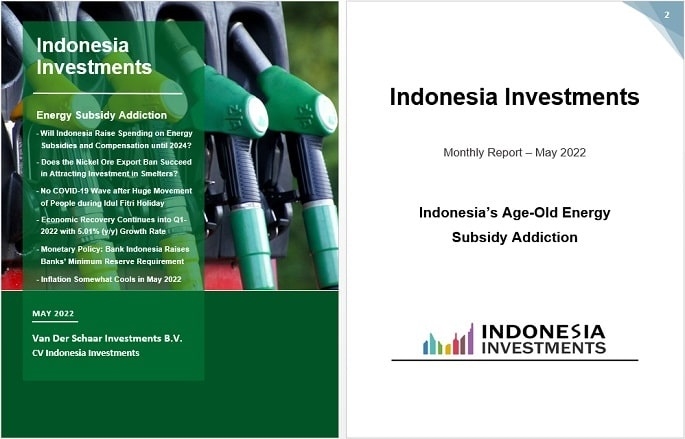Waspadalah terhadap penipu yang aktif di WA mengatasnamakan Indonesia Investments
15 April 2025 (closed)
Jakarta Composite Index (6,441.68) +73.17 +1.15%
Indonesia’s Age-Old Energy Subsidy Dilemma; Government Adds USD $20 Billion to 2022 Budget
The Indonesian government’s energy subsidy spending has always been a topic of controversy. By keeping fuel and electricity prices low the central government aims to support the Indonesian people as well as the micro, small and medium enterprises (MSMEs) as – indeed – poverty remains a big problem in Indonesia; a country where nearly ten percent of the population lives below the national poverty line (which is 26.5 million individuals in absolute terms).
Moreover, the poverty threshold set by Indonesia is typically a low one (slightly over USD $1.00 per day), which is much lower than the threshold used by the World Bank (at USD $1.90 per day). In other words, if we would use the World Bank’s threshold on Indonesia, then we would see a significant increase in the country’s poverty rates. And so, poverty is in fact a bigger problem in Indonesia than the official government data show. With that in mind, even mild inflationary pressures can push millions of Indonesians into full-blown poverty. Therefore, state assistance in the form of cheap energy (amid rising inflation) indeed helps to safeguard people’s purchasing power.
On the other hand, various international organizations have repeatedly expressed criticism on Indonesia’s energy subsidy policies over the past couple of decades, for a number of reasons:
- Energy subsidies create market distortions as they keep prices of fossil fuels artificially low (hence prices of essentially all goods and services in society are kept low in an artificial manner). It also encourages overconsumption as well as pollution. And, in the case of Indonesia where infrastructure development is generally inadequate it also leads to traffic congestion (which also triggers economic costs);
- Many doubt that energy subsidies are effective in terms of alleviating inequity and poverty as most of the benefits are accrued by wealthier households that already have high consumption levels. A couple of years ago, the World Bank concluded that the richest decile of Indonesian households consumed around 40 percent of subsidized gasoline, while the poorest decile consumed less than one percent. The World Bank therefore feels that direct benefit transfers are much more effective. However, we need to add here that cheap fuel also allows various (food) products and services to be cheaper as transportation costs are lower. So, in an indirect manner, we do see some significant advantage for the poorer households obtained from low energy prices;
- Spending on energy subsidies (for consumptive purposes) implies that there are missed opportunities in terms of public financing of productive purposes (such as social protection, healthcare, education, and infrastructure);
- At some point in time energy subsidies for fossil fuels have to be phased out because the availability of fossil fuels is limited, implying they become more and more expensive. The longer governments wait before reducing subsidies the more it will hurt once the subsidies are phased out. However, this point is not really valid anymore since there have been great advances with renewable energy sources. Therefore, well before fossil fuels are used up, there will be a switch to renewables. However, to make this switch easier it would possibly be better if governments focus on subsidizing renewable energy sources.
These energy subsidies have also become political tools. We have often seen that the Indonesian government becomes more generous in terms of energy subsidies ahead of general elections. Meanwhile, cutting the energy subsidies is bound to be met with protests on the streets (encouraged by political opponents of the ruling parties).
Meanwhile, the points above involve price cuts for the end-user. But there are also production subsidies in the form of fiscal incentives or the cost recovery scheme.
[...]
This is only the introduction of the article. In case you want to read the full article you can order our May 2022 report (an electronic report) by sending an email to info@indonesia-investments.com or a message to +62.882.9875.1125 (including WhatsApp).
Take a glance inside the report here!
Price of this report:
Rp 150,000
USD $10,-
EUR €10,-

Bahas
Silakan login atau berlangganan untuk mengomentari kolom ini
